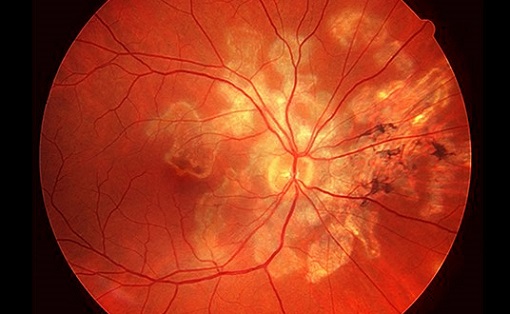Serpiginous Choroiditis, a rare and potentially blinding eye condition surfaces as a result of COVID-19 infection
Nikhil Prasad Fact checked by:Thailand Medical News Team Nov 17, 2024 5 months, 10 hours, 52 minutes ago
Medical News: Doctors Warn of Alarming Ocular Condition
While most of the world is familiar with the respiratory implications of COVID-19, its effects on other organ systems remain an evolving story. Among these, the virus's impact on ocular health has gained increasing attention. The latest report, led by researchers from Dalhousie University's Department of Ophthalmology and Visual Sciences in Halifax, Canada, sheds light on a unique and troubling case of serpiginous choroiditis - a rare and potentially blinding eye condition - manifesting after a COVID-19 infection. This
Medical News delves into the detailed findings of this groundbreaking case.
 Serpiginous Choroiditis, a rare and potentially blinding eye condition surfaces as a result of COVID-19 infection
Serpiginous Choroiditis, a rare and potentially blinding eye condition surfaces as a result of COVID-19 infection
Serpiginous choroiditis is an inflammatory condition affecting the choroid and retinal pigment epithelium, leading to progressive atrophy and, often, severe vision loss. This disease is typically observed in healthy individuals with no prior ocular history, making this case particularly intriguing. The report provides insight into the first documented instance of macular serpiginous choroiditis developing in the aftermath of COVID-19.
A Closer Look at the Case
The subject of this report is a 28-year-old Navy serviceman who presented with sudden and significant vision impairment in his left eye. The symptoms followed a series of events, beginning with a confirmed COVID-19 infection. Notably, the patient experienced recurring headaches, nausea, and intermittent blurred vision before developing severe visual disturbances two months post-infection.
On initial examination, the patient’s vision in his left eye had deteriorated to the point of counting fingers, while his right eye remained unaffected. Advanced imaging techniques, including spectral-domain optical coherence tomography (OCT), revealed significant damage to the retina, characterized by atrophy and progressive choroidal inflammation. These findings pointed to serpiginous choroiditis, confirmed after ruling out other potential causes such as infections, trauma, or preexisting retinal conditions.
Imaging and Diagnostic Revelations
The diagnostic process included a battery of tests and imaging modalities. Fundoscopy revealed a striking gray-yellow lesion in the macula of the left eye, accompanied by choroidal ischemia - an indicator of restricted blood flow - observed on OCT angiography. Meanwhile, indocyanine-green angiography highlighted a lack of choroidal perfusion in affected areas. OCT scans captured the rapid progression of retinal atrophy, with significant thinning of the choroid over just four months.
The patient’s immune system markers and infectious disease screenings, including tests for tuberculosis, syphilis, and herpes viruses, all returned negative. This thorough investigative work pointed to an exaggerated inflammatory response potentially triggered by SARS-CoV-2, the virus responsible for COVID-19.
Treatm
ent and Outcomes
The initial treatment approach involved high-dose oral corticosteroids, a standard therapy for active serpiginous choroiditis lesions. However, after a month with no improvement and emerging side effects, the treatment regimen was adjusted to include azathioprine, an immunosuppressive medication. Despite these interventions, the prognosis for the affected eye remains poor due to the extensive damage to critical retinal structures.
Interestingly, the patient’s choroidal thickness fluctuated significantly throughout the disease course. These changes, from an initial swelling during acute inflammation to eventual thinning as the condition progressed, align with patterns seen in inflammatory eye diseases, adding a new layer of understanding to the disease process.
Insights from the Study
This case adds to the growing body of evidence linking COVID-19 to a range of ocular complications. While causation cannot be definitively established, the temporal relationship between the patient’s infection and the onset of serpiginous choroiditis underscores the need for further investigation into the virus's role as a potential trigger for autoimmune or inflammatory eye diseases.
In prior studies, other types of posterior uveitis, such as ampiginous choroiditis and multifocal choroiditis, have been reported following COVID-19. This report is unique in its focus on the macular variant of serpiginous choroiditis, which is notably rare and associated with an unfavorable prognosis due to early foveal involvement.
The study’s authors speculate that the choroid's dense vascular network may render it particularly vulnerable to inflammation triggered by systemic infections like COVID-19. This hypothesis aligns with other reports of COVID-19-associated retinal and vascular changes, though much remains to be explored.
The Bigger Picture
The findings of this study not only highlight the devastating impact of serpiginous choroiditis but also raise important questions about the long-term implications of COVID-19 on eye health. The condition, though rare, represents a significant challenge due to its complex diagnosis and management. It also serves as a reminder for clinicians to remain vigilant for atypical symptoms in patients recovering from COVID-19.
For individuals, the study underscores the importance of seeking prompt medical attention for any unusual visual disturbances, particularly in the weeks and months following a COVID-19 infection.
Conclusion
This case represents a critical step in understanding the potential ocular complications of COVID-19. By presenting detailed imaging findings and a comprehensive diagnostic process, it provides a valuable reference for clinicians worldwide. While the exact mechanisms remain uncertain, the study opens the door for further research into the interplay between systemic viral infections and ocular inflammation.
The study findings were published in the peer-reviewed Journal of VitreoRetinal Diseases.
https://journals.sagepub.com/doi/full/10.1177/24741264241297936
For the latest COVID-19 News, keep on logging to Thailand
Medical News.
Read Also:
https://www.thailandmedical.news/news/mild-covid-19-can-cause-eye-artery-blockages
https://www.thailandmedical.news/news/breaking-even-mild-covid-19-can-cause-microvasculature-changes-of-the-optic-nerve
https://www.thailandmedical.news/news/visual-complications-linked-to-covid-19-infection
